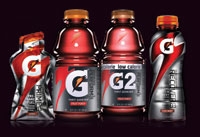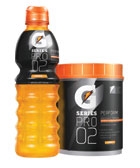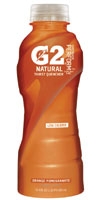
As Gatorade embarked on the relaunch of its beverage portfolio, the PepsiCo division conducted extensive research, reaching out to 10,000 elite high school athletes and sports health professionals, along with professional athletes across the country. “We spent time talking to the likes of Serena [Williams] and Usain Bolt but also [had] 10,000 interactions with everyday athletes, and it was just so interesting to see how common the needs were,” says Gatorade’s chief marketing officer Sarah Robb O’Hagan. “The words coming out of a 14-year-old football player’s mouth were just the same as a professional player. It was amazing in a way.”
Gatorade learned that athletes were looking for products that addressed the body’s performance needs before, during and after sports activities. The research also showed the possibilities for the brand in the category, finding that Gatorade was well regarded for its scientific formula and that it ranked as the no. 3 sports brand after Nike and Adidas. O’Hagan, coincidently, joined Gatorade (in mid-2008) from Nike, which, she says, gave her perspective on the preferences of athletes.
“The single biggest commonality is the fact that the sports equipment companies have taught these consumers to have a voracious appetite for innovation,” O’Hagan says. “It was easy to see there was an opportunity to take a brand like Gatorade, with [its] incredible strength and [the] trust that it has [with] these very elite consumers, and take it to so many more places.”
The journey began in February, when Gatorade previewed its G Series line of functional drinks on the sidelines of the Super Bowl; the official rollout hit last April. Developed on a three-tiered platform, the G Series line includes pre-performance carbohydrate gels (called “Prime 01”), a redesigned Gatorade Thirst Quencher and low-calorie G2 drink (Perform 2) and protein-enhanced sports beverages (Recover 3)- all designed to meet hydration and nutrition needs before, during and after a workout.

The launches of G Series and G Series Pro are significant, according to O’Hagan, because they represent Gatorade’s shift from a sports drink manufacturer to a sports performance innovation company.
“One of our mantras is that, for some beverages, innovation is really about being new and different, like rolling out new flavors. But for a sports performance innovation company, innovation has to be about new and better, products that really help the athlete improve their performance,” she says.
That repositioning for Gatorade began almost two years ago, in early 2009 when it unveiled its new “G” brand identity. The switch to G was a move to bring back the “heart, hustle and soul of the brand,” O’Hagan explained during a recent investor meeting.
The new G identity also aimed to energize the brand for teens, which is a target demographic for the company.
“When you’re in your teen years, you develop your deep emotional connection with things,” O’Hagan says. “So it’s such an important time for us to begin the brand relationship with the consumer. We’ve always seen them as our focus.”
To ensure Gatorade engaged that teen demographic, O’Hagan said the brand re-evaluated its marketing strategy.
“We needed to step up our focus on that consumer and our thought process around how to connect with that consumer,” she says.

"We are in a very enviable position in that we bring valuable knowledge to the consumer,” O’Hagan says. “We have 40 years of science in The Gatorade Sports Science Institute, and this particular consumer base is looking for knowledge and we can provide that solution. So it was a very easy decision to empower the teen athlete community to take that knowledge and run with it. It’s certainly worked for us, and it’s something that we intend to keep pushing on.”
Through the repositioning process, Gatorade also realized how deeply loyal athletes are to the brand.
“Serena [Williams] talked a lot about how she has been using the product since she was 4 years old,” O’Hagan says. “For her to be part of the process of figuring out the next iteration of Gatorade was so exciting for her. It was also so interesting to see how important our products are within her training regimen and how excited she was, obviously, for what we were able to do with it.”
Gatorade wanted to really capitalize on that loyalty, so it went big with the G Series debut, launching it in back-to-back television ads during the NBA Playoffs in April. The first spot, called Gatorade Has Evolved, took viewers back to the time when basketball hoops were made of peach baskets, tennis racquets were wooden and the only hydration option was water. The commercial then showed athletes, such as basketball’s Michael Jordan and soccer’s Mia Hamm, that Gatorade has fueled since it was introduced in 1965. Finally, the brand’s evolution reaches 2010, as G Series changes sports performance once again.
The retrospective ad set the stage for Before, During and After, an ad that tells the story of the G Series products and the three-tiered platform they’re based on. In this spot, track world record holder Usain Bolt, professional basketball player Dwight Howard and professional football player Peyton Manning document their experiences as they prepare, perform and recover after competition-all with G Series products.
At retail, Gatorade created new signage and displays to communicate the three tiers of G Series and the products’ benefits. The in-store branding also was important for the exclusive launch of G Series Pro at GNC stores.
“GNC has been such a predominant player in taking the idea of elite nutrition and making it more accessible,” says O’Hagan. “What we found from our exploratory conversations with them was that they have these consumers coming in every day who were asking for these products that we had, and it was just so clear that the time had arrived.”
The company indicates that its strategy of distributing G Series Pro through non-traditional channels like GNC is just another sign of its transformation from a sports drink company to a sports performance innovator. After launching G Series Pro at GNC, the brand extended distribution of the line to Dick’s Sporting Goods stores, and O’Hagan hints that the company has “aggressive plans” to expand G Series Pro’s distribution beyond that.
Gatorade also recently introduced G Natural and G2 Natural at select Whole Foods Markets-the result of company research that indicated a significant group of athletes were looking for the benefits of a proven sports drink like Gatorade Thirst Quencher but preferred to consume only natural products.
O’Hagan says Gatorade is focused on the G Series, G Series Pro and natural launches, but that they are only the beginning of a transformation for the brand.
“We actually have a lot more to come because we’re really holding ourselves to this idea of relentless innovation and making sure that pipeline is fully stocked,” she says.
The idea of moving away from sports drinks to sports performance innovation means, by definition, that Gatorade is segmenting to grow.
“We are looking at the more nuanced needs of different athletes and making sure we are meeting those needs in unique ways,” O’Hagan says. “All I can say to that is keep looking for more from us because this is just the beginning of a journey.” BP
Editor’s Note: This feature was excerpted from a story that originally ran in our sister publicationBeverage Industry.
